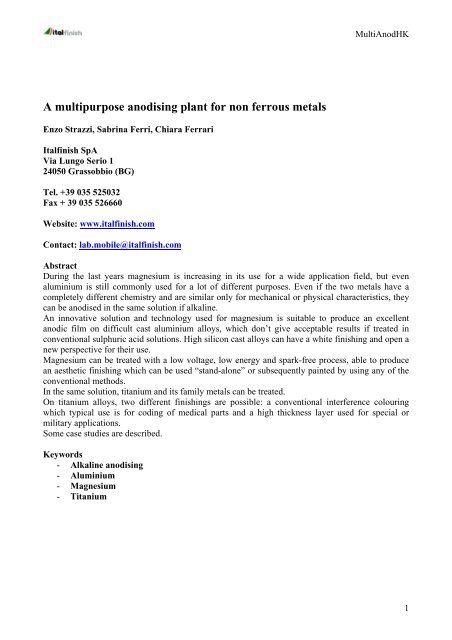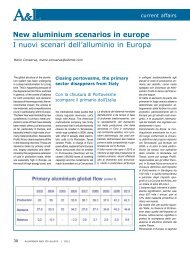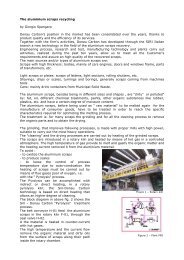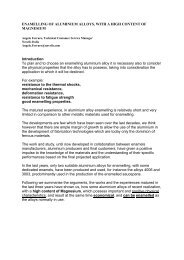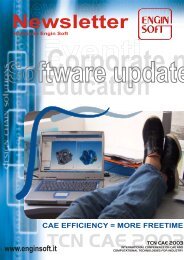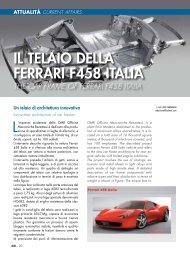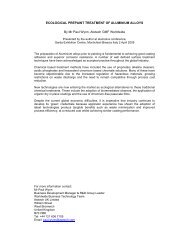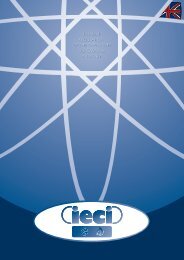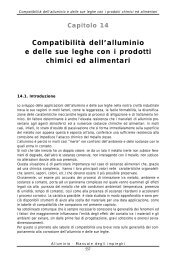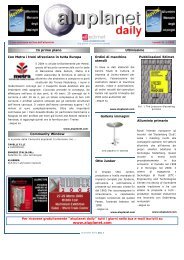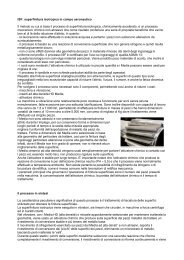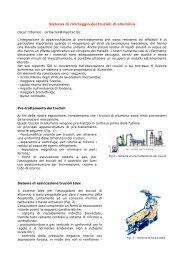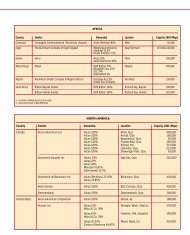A multipurpose anodising plant for non ferrous metals - Aluplanet
A multipurpose anodising plant for non ferrous metals - Aluplanet
A multipurpose anodising plant for non ferrous metals - Aluplanet
You also want an ePaper? Increase the reach of your titles
YUMPU automatically turns print PDFs into web optimized ePapers that Google loves.
MultiAnodHK<br />
A <strong>multipurpose</strong> <strong>anodising</strong> <strong>plant</strong> <strong>for</strong> <strong>non</strong> <strong>ferrous</strong> <strong>metals</strong><br />
Enzo Strazzi, Sabrina Ferri, Chiara Ferrari<br />
Italfinish SpA<br />
Via Lungo Serio 1<br />
24050 Grassobbio (BG)<br />
Tel. +39 035 525032<br />
Fax + 39 035 526660<br />
Website: www.italfinish.com<br />
Contact: lab.mobile@italfinish.com<br />
Abstract<br />
During the last years magnesium is increasing in its use <strong>for</strong> a wide application field, but even<br />
aluminium is still commonly used <strong>for</strong> a lot of different purposes. Even if the two <strong>metals</strong> have a<br />
completely different chemistry and are similar only <strong>for</strong> mechanical or physical characteristics, they<br />
can be anodised in the same solution if alkaline.<br />
An innovative solution and technology used <strong>for</strong> magnesium is suitable to produce an excellent<br />
anodic film on difficult cast aluminium alloys, which don’t give acceptable results if treated in<br />
conventional sulphuric acid solutions. High silicon cast alloys can have a white finishing and open a<br />
new perspective <strong>for</strong> their use.<br />
Magnesium can be treated with a low voltage, low energy and spark-free process, able to produce<br />
an aesthetic finishing which can be used “stand-alone” or subsequently painted by using any of the<br />
conventional methods.<br />
In the same solution, titanium and its family <strong>metals</strong> can be treated.<br />
On titanium alloys, two different finishings are possible: a conventional interference colouring<br />
which typical use is <strong>for</strong> coding of medical parts and a high thickness layer used <strong>for</strong> special or<br />
military applications.<br />
Some case studies are described.<br />
Keywords<br />
- Alkaline <strong>anodising</strong><br />
- Aluminium<br />
- Magnesium<br />
- Titanium<br />
1
MultiAnodHK<br />
Notes:<br />
1. In the present paper no didactic or scientific aspect will be dealt; who is interested can<br />
refer to some previous work of the same Authors. (1-7)<br />
2. Part of the same subject is included in AAC Annual Conference Proceedings of 2007 (8)<br />
3. Part of the same subject is included in Alumotive 2007 Conference Proceedings (9)<br />
1- Foreword<br />
Magnesium as explained in a recent congress can have a very broad horizon (8) assuming<br />
suitable treatment is used to protect it against corrosion. As a regulation in <strong>for</strong>ce (10) limits the use /<br />
presence of chromium salts in automotive and electronics, the chemical conversion treatments<br />
known as Dow 1, 19, 21 or <strong>anodising</strong> ones like Dow 17 and Dow HAE, because all using chromic<br />
acid in the treatment solutions and chromium (VI) must be substituted by something more<br />
environmental friend. Such treatments, dating back to ‘40s – ‘50s, are well known and still included<br />
in ASTM and MIL Specs, but cannot be applied in the mentioned fields.<br />
Chrome free conversion coating on magnesium are not always completely satisfactory on<br />
magnesium especially when the base material is not so good as casting quality or because the alloy<br />
is aluminium free.<br />
There is an important demand to have a good quality treatment <strong>for</strong> cast aluminium materials<br />
especially <strong>for</strong> high silicon containing alloys. It’s true that in a medium term, magnesium should<br />
replace a wide part of cast aluminium, but at the present time even aluminium products are<br />
available on the market and need. A good corrosion and aesthetic finishing of high silicon content<br />
aluminium alloys are not easy but the method proposed by us is really well promising.<br />
We observed the same solution can be used <strong>for</strong> titanium materials and the results are<br />
interesting even from an aesthetic point of view.<br />
Originally, our process was studied <strong>for</strong> magnesium but its extension to cast aluminium appeared<br />
innovative and giving excellent results even on cast aluminium, allowing an innovative white<br />
finishing on it.<br />
In our description we follow the trend of our research starting from magnesium and passing<br />
to aluminium and to titanium.<br />
2 – Anodising magnesium<br />
Even when alloyed with other <strong>metals</strong>, magnesium remains a very reactive metal, especially<br />
in presence of acids or in corrosive environments, in general. In these situations, there<strong>for</strong>e, a<br />
conversion coating, even when correctly applied and followed by a good paint, is not always<br />
suitable to protect the materials against the corrosion. To protect better magnesium materials and<br />
improve the adhesion of a subsequent paint, a method to <strong>for</strong>m, under current, a “composite” layer,<br />
which can be over 20 micron thick, has been studied.<br />
When a magnesium piece is immersed in an alkaline solution containing ions able to react<br />
with such a metal, and connected to a positive pole of a current rectifier, a dense scantly conductive<br />
layer is <strong>for</strong>med on the metal. Its composition depends on the composition of the solution and its<br />
thickness is related to the passed current.<br />
Magnesium is anodised in an alkaline solution.<br />
In theory, any alkaline solution can <strong>for</strong>m a layer on magnesium alloys, but in the industrial practice<br />
the chosen anions are those able to <strong>for</strong>m chemical complex or salts with magnesium. The cation has<br />
a minor influence and is chosen among the alkaline ions or ammonia.<br />
When using certain compositions sparks occur in the solution.<br />
The sparks <strong>for</strong>mation is quite impressive as shown in figure 1.<br />
The photo shows a “light effect” produced in the <strong>anodising</strong> solution caused by the sparks between<br />
anode and cathode. The amount of energy <strong>for</strong>med and partly “wasted” in these conditions is<br />
2
MultiAnodHK<br />
significant. Part of the current, in fact, is lost as heat that increases the temperature of the tank (that<br />
a suitable chiller maintains in the correct range.<br />
Figure 1 – Micro-arc or spark <strong>anodising</strong> process per<strong>for</strong>med on Italfinish pilot <strong>plant</strong><br />
3 – Description of our process.<br />
When we were asked to set up an <strong>anodising</strong> process <strong>for</strong> magnesium alloys the main issues<br />
concerning it were:<br />
- it should be simple,<br />
- it should be environmental friend and low energy consumption,<br />
- It should be suitable <strong>for</strong> different magnesium alloys.<br />
- It should give a pleasant aesthetic finishing because, probably, some pieces could<br />
remain as-prepared without any additional post-treatment or covering top coat.<br />
- In practice, it is “low cost” because to be applied to mass production items, where<br />
the finishing cost should not be a significant part of the total cost.<br />
When we started to find some basic data about the pre-treatments be<strong>for</strong>e <strong>anodising</strong>, we found a lot<br />
of data (11) but essentially all the methods included<br />
- an alkaline degreasing,<br />
- An acid etching or activation using different acids, some of them really harmful like<br />
chromic, hydrofluoric or nitric.<br />
For sure, this type of chemicals was out of our basic statements mentioned above even when we<br />
decided to use more friendly acids, the results were surprising and controversial.<br />
Even comparing similar and very simple alloys like AZ91 or AZ31 we have some surprising<br />
results:<br />
1- Some parts, essentially extrusions; after acid etching appeared silvery and “bleached”.<br />
3
MultiAnodHK<br />
2- Some other items, more frequently on cast parts (but not always), <strong>for</strong>med a thick black<br />
patina that partly could remain even after our <strong>anodising</strong> step.<br />
The reason of the different behaviour is related to production technology, type of “protective” gas<br />
used and the injection and /or cooling system especially on cast part.<br />
We were widely in<strong>for</strong>med about the “SF 6 Reduction Partnership” proposed by US<br />
Environment Protection Agency EPA and the conferences yearly organised (12), but our main task<br />
was to avoid the problem, because we were acting as “job” anodisers not as expert of magnesium<br />
die casting or extrusion.<br />
Figures 2 & 3 are examples of the mentioned problem.<br />
(a)<br />
(b)<br />
Figure 2 – Examples of magnesium extrusion partly etched in acid solution <strong>for</strong> 15 second (right<br />
part) (13)<br />
(a)<br />
(b)<br />
Figure 3 – The same die cast be<strong>for</strong>e and after acid etching (13)<br />
4
MultiAnodHK<br />
The sole way to avoid the problem was to skip the acid step and any pre-treatment in general.<br />
To do so, we had only one way: to per<strong>for</strong>m the cleaning and subsequent step with an electrolytic<br />
step.<br />
We contacted an important Italian manufacturer named Elca (14) asking to prepare a special current<br />
supplier fitted with a PLC to manage type and duration of the supplied current / voltage.<br />
The prototype manufactured <strong>for</strong> us was successful and the machine is in production and some<br />
pieces already sold. The features of that machine are available in the mentioned website.<br />
Figure 4 – Current supply and its special control board (14)<br />
A correct combination of type of current and time gave a positive result even because when the<br />
magnesium items had no so good die casting process the aspect was better if processed without any<br />
preliminary step. When the material is originally good, we had exactly the same result with or<br />
without a preliminary acid dipping.<br />
Our process is now known as SweetMag<br />
SweetMag is a new <strong>anodising</strong> process <strong>for</strong> magnesium alloys characterised by the following<br />
features:<br />
- No pre-treatment is necessary (i.e. the magnesium pieces is immediately treated in<br />
the <strong>anodising</strong> solution)<br />
- No harmful or toxic components are present in the electrolytic solution.<br />
- The solution is long-life and easily maintained by simple additions of the consumed<br />
chemicals.<br />
- A simple chemical control can ensure the correct concentration of the chemicals.<br />
- The components of the solution are basic chemicals that can be purchased on the<br />
market.<br />
5
MultiAnodHK<br />
- The process is energy saving because working at low current density and,<br />
consequently, at low voltage) compared with similar processes of industrial use).<br />
- The production cost is 1/3 of that of one of the most popular processes available on<br />
the market.<br />
- The process can be full automatic and manpower is necessary only <strong>for</strong> racking and<br />
un-racking the pieces.<br />
- The same process, with the same solution can be used even <strong>for</strong> aluminium, titanium<br />
and zinc alloy alloys.<br />
- Different magnesium alloys can be treated with no modification of the operational<br />
parameters, and mixed even in the same load.<br />
- The finishing is smooth, even has aesthetic quality.<br />
- The finishing can be used as “stand-alone” (i.e. with no additional treatment).<br />
- The <strong>for</strong>med layer is suitable <strong>for</strong> wet paint or powder coating.<br />
- The <strong>for</strong>med layer is suitable <strong>for</strong> an electrophoretic (ED) paint with any of the<br />
processes available on the market.<br />
Table 1 represents a summary of SweetMag process<br />
Table 1 - SweetMag process<br />
Parameter Description Notes<br />
Type of finishing • Stand-alone anodizing<br />
1, 2, 3<br />
• Anodising + adsorption colour<br />
• Anodising + powder coating<br />
• Anodizing + wet paint<br />
• Anodising + ED paint<br />
Type of metal - Magnesium (any alloy)<br />
4<br />
- Aluminium (any alloy including highsilicon<br />
ones)<br />
- Titanium (any alloy but the aesthetic result<br />
depends on the alloy). This type of<br />
finishing can be considered according to<br />
the American MIL Specs.<br />
Type of treatment Electrochemical, operated in the same chemical<br />
solution, by means a special electrical supply<br />
managed PLC<br />
Type of pre-treatment Not necessary in some cases detrimental 5<br />
Type of post-treatment According to the final application:<br />
• Not visible sealing<br />
• Powder coating<br />
• Wet paint<br />
• ED paint<br />
Any paint coat can be considered as a base coat, to<br />
which the final customer can add his final top coat,<br />
according to his real need. Top coats can be applied<br />
even by the final user of the items.<br />
Type of <strong>plant</strong><br />
Full automatic, including wastewater recycling and 6<br />
Chemical<br />
(electrolyte)<br />
solution<br />
fume suction and recycling.<br />
Diluted alkaline solution, free from chromates,<br />
borates and fluorides. The solution is long-life.<br />
6
MultiAnodHK<br />
Maintenance of the • Replenishing the consumption by addition<br />
solution<br />
according to specific, simple chemical<br />
analysis.<br />
• By filtration<br />
Temperature 20 ± 5 °C (preferred) 7<br />
Phases of the<br />
electrolytic process<br />
Current density (in the<br />
<strong>anodising</strong> step)<br />
Voltage (in <strong>anodising</strong><br />
<strong>for</strong> 20 µm layer)<br />
Total cycle time (<strong>for</strong> 20<br />
microns)<br />
Notes<br />
• Cleaning and activation step. This proprietary<br />
step is necessary to eliminate any grease, oil<br />
or friable part from the surface and making it<br />
reactive to the subsequent process.<br />
• Anodising<br />
2.0 A/dm 2 8<br />
• Below 300 (maximum)<br />
9<br />
• Below 180 (average)<br />
18 minutes 10<br />
1. Thickness of the anodic layer ranging from 5 to 25 microns,<br />
according to the customer’s request or final application. Thicker<br />
layer has no technical meaning.<br />
2. The anodic layer can be coloured by adsorption, if using special<br />
organic dyestuffs, but the aesthetic effect is not comparable with<br />
same treatment on aluminium<br />
3. The adhesion of any subsequent paint is excellent, but the<br />
behaviour depends on the type of paint. Multi-layer paint is<br />
possible by applying a correct procedure.<br />
4. Different <strong>metals</strong> can be joined together.<br />
5. In case of superficial defects or problems on cast pieces, a soft<br />
deburring or basting step is suggested. In case of blasting, it’s<br />
advisable to avoid any metallic or metal containing media,<br />
because able to cause corrosion pitting during storage.<br />
6. The <strong>plant</strong> can be organised as a “closed boxes” system when<br />
manpower is used only <strong>for</strong> racking and un-racking. A proprietary<br />
close loop system can be used to recycle waste and fume<br />
7. The temperature of the solution influences the voltage necessary<br />
to maintain the preset current, and should be chosen according to<br />
the final application. The influence of the temperature on the layer<br />
characteristics is not so evident.<br />
8. This value was decided <strong>for</strong> all the alloys and coating thickness.<br />
The process can operate even at lower current density, because the<br />
<strong>for</strong>med layer is conductive and no high current density is<br />
necessary to “per<strong>for</strong>ate” the <strong>for</strong>med layer and maintain the<br />
conductivity. No spark <strong>for</strong>mation.<br />
9. The maximum and average voltage depends:<br />
• Final thickness of the layer<br />
• Alloy<br />
• Temperature of the solution<br />
10. All the operational parameters have been chosen to produce 3<br />
loads/hour with 20 µm- layer. Due to the type of process,<br />
thickness and time are not strictly proportional.<br />
7
MultiAnodHK<br />
3.1 - SweetMag in practice (magnesium)<br />
This section is a photographic documentation of some application of our technology.<br />
§ 1 – Example of industrial production<br />
The request was:<br />
• 15 µm anodic coat<br />
• Powder top coat (the powder was supplied by the customer)<br />
The result is shown in figures 5 – 9<br />
Figure 5 – Multi-purpose pilot line in Italfinish<br />
8
MultiAnodHK<br />
Figure 6 – Particular of the control board of the current supply almost at the end of the process.<br />
The full control board is shown in figure 4.<br />
Figure 7 – Anodised pieces ready to enter the powder coating booth, (on the left) and subsequently<br />
to the curing oven (on the top)<br />
9
MultiAnodHK<br />
Figure 8 – The powder coated pieces after the curing oven (on the top)<br />
Figure 9 – One of the pieces after powder coating and ready to package. The sample is same type<br />
of figure 3, and no evidence remained of the previous superficial problems.<br />
§ 2 – Wheels<br />
Cast magnesium wheels are common items. Figures 10 – 13<br />
10
MultiAnodHK<br />
Figure 10 – Motorcycle AZ91 cast wheel parts (13).<br />
Figure 11 - Scooter wheel after <strong>anodising</strong> (13). The brown plastic tape has been used to cover a<br />
mild steel insert present in the sample we received.<br />
11
MultiAnodHK<br />
Figure 12 – Scooter wheel after <strong>anodising</strong> and epoxy base coat by DuPont. The additional coats<br />
will be added by the final customer later. (13)<br />
Figure 13 – Motorcycle cast wheel after <strong>anodising</strong> and wet paint (by DuPont) (13)<br />
§ 3 – Forged parts (alloy ZK60)<br />
ZK60 is a special alloy very difficult to treat. Anodising is the most reliable process.<br />
12
MultiAnodHK<br />
Figure 14 – Motorcycle ZK60 <strong>for</strong>ged wheel parts (13).<br />
Figure 15 – Forged wheel-hub with no treatment. (13)<br />
13
MultiAnodHK<br />
Figure 16 – Forged wheel-hub after <strong>anodising</strong> and epoxy base coat (13)<br />
Figure 17 – Forged wheel part after <strong>anodising</strong> and ED paint (BASF)<br />
14
MultiAnodHK<br />
§ 4 – Special finishings<br />
Special decorations are possible on anodised magnesium by using our proprietary technology. This<br />
way can open new frontiers to magnesium in furnishings<br />
Figure 18 – Special decoration on magnesium sheet (13)<br />
A slightly modified solution seems to be able to produce a uni<strong>for</strong>m black colour without any<br />
further dipping step. (15)<br />
15
MultiAnodHK<br />
Figure 19 – AZ 31B sheets appearing black after a modified version of SweetMag process (15)<br />
Figure 20 – ZK 60 motorcycle wheel. (1)- Not treated, (2) Standard SweetMag treated, (3)<br />
appearing black after a modified version of SweetMag process (15)<br />
By using a modified solution a black film is <strong>for</strong>med while the layer <strong>for</strong>med. The surface is<br />
usually smooth and uni<strong>for</strong>m in colour. As in any “integral” colouring process, the result is highly<br />
influenced by alloy and type of mechanical process used to obtain the item.<br />
16
MultiAnodHK<br />
3.2 - SweetMag in practice (aluminium)<br />
The process shows a certain validity when used on high silicon aluminium containing alloys,<br />
because able to produce a clear finishing even over 12% Si... The anodic layer doesn’t show the<br />
blackish aspect, frequently with patina, typical of any sulphuric based <strong>anodising</strong> on that alloy, as<br />
shown in figure 18. This type of anodizing is an excellent pre-treatment to a subsequent paint<br />
because not <strong>for</strong>ming any superficial patina. High silicon aluminium alloys, usually; give a not<br />
completely satisfactory result when painted after any conventional chemical conversion due to a<br />
scarce adhesion of the paint layer.<br />
Figure 21 – AlSi12 die-cast alloy anodised aluminium<br />
The process allows a white finishing on die cast wheels. The finishing can be used both standalone<br />
or as a base <strong>for</strong> a subsequent painting step cording to any of the standard process.<br />
17
MultiAnodHK<br />
Figure 22 – Part of motorcycle dye-cast wheel after our proprietary alkaline anodizing.)<br />
Figure 23 – Hub of the previous wheel after alkaline anodizing and powder coating<br />
18
MultiAnodHK<br />
Figure 24 – AlSi12 alloy after our proprietary alkaline anodizing.<br />
Figure 25 – AlSi12 alloy after our proprietary alkaline anodizing.<br />
19
MultiAnodHK<br />
What is absolutely evident from our tests and from the previous photos is that alkaline anodizing<br />
can give a white finishing even on high silicon content.<br />
We gave no real problem to achieve 15 – 20 micron layers even on high silicon dye cast parts. Even<br />
the presence of difficult alloying <strong>metals</strong> like copper or lead has not so adverse effect on thickness or<br />
aspect. Even the “marble” effect produced by a not excellent injection step is minimized in alkaline<br />
anodizing.<br />
The adhesion of a subsequent paint is excellent and absolutely better than with any other type pf<br />
existing conversion coating because no patina or mobile or fragile part is <strong>for</strong>med or remains on the<br />
surface. Excellent finishings are achieved on good quality 6xxx or 5xxxx aluminum parts. The<br />
white / opaque tone is evident.<br />
Figure 26 – AA 6082 aluminum mechanical part used, after our proprietary alkaline anodizing<br />
20
MultiAnodHK<br />
Figure 27 – 1xxx aluminum car parts be<strong>for</strong>e and after our proprietary alkaline anodizing<br />
Figure 28 – AA 4xxx aluminium pan after our proprietary alkaline anodizing. Treated in a standard<br />
sulphuric acid solution, the colour is deep grey / black according to the thickness and type of<br />
process.<br />
21
MultiAnodHK<br />
Figure 29 – AA 1xxx aluminum pan after our proprietary alkaline anodizing<br />
The samples depicted in figures 18 - 26 show the white / opaque effect achieved using one step<br />
process is quite significant. The <strong>for</strong>med layer has a significant covering effect able to mask even<br />
evident extrusion lines. Our quality control tests gave absolutely promising results and they will be<br />
continued on specific samples to meet any special requirement from the final customer<br />
3.2 - SweetMag in practice (titanium & friends)<br />
We used the same solution to treat titanium and tantalum and the results are absolutely interesting<br />
and attractive.<br />
The same solution is suitable <strong>for</strong> zirconium, vanadium or hafnium, but we had no chance to find<br />
industrial pieces of those materials.<br />
Figure 30 shows some tantalum pieces anodised in the same solution used <strong>for</strong> magnesium. At high<br />
current density a dense thick white oxide layer is <strong>for</strong>med. At lower current density tantalum is<br />
coloured similarly to titanium. Colour is generated by a light interference effect caused by an<br />
anodic layer which thickness is below 1 micron. The <strong>for</strong>med colour depends on the applied voltage<br />
and not on the treatment time. Its behaviour is similar to that of titanium, which is its chemical<br />
homologue.<br />
Figures 31&32 show the same treatment applied on titanium and the colours are quite similar.<br />
Using a proprietary post-treatment the interference colours produced in this way can be protected<br />
against fading and. corrosion.<br />
22
MultiAnodHK<br />
Figure 30 – Tantalum anodised pieces by using SweetMag process. (13)<br />
Figure 31 – Anodised titanium. (13) The layer is 20 micron thick and the layer fulfils the American<br />
Aerospace Specs in <strong>for</strong>ce (16).<br />
23
MultiAnodHK<br />
Figure 32 – Interference colours produced on titanium pieces (13)<br />
24
MultiAnodHK<br />
3 – The quality control of the finishing produces with SweetMag<br />
Note: Be<strong>for</strong>e any decision to start our production a long series of tests was specifically per<strong>for</strong>med<br />
by Qualital Laboratory of Cameri (NO) on samples prepared by Italfinish (17)<br />
A very serious problem we had to face with magnesium materials was that there are no<br />
“official” specifications <strong>for</strong> quality control of magnesium finishing treatments.<br />
There are some “internal specs.” filed by the Companies or Groups of automotive or<br />
aeronautical field the “supplier” has to fulfil to be accepted in the “supplier’s list”.<br />
All this is absolutely regular, but according our opinion it should be necessary to have some<br />
“basic” regulation to which everybody can refer.<br />
For the tests described below, some tests are derived from those used <strong>for</strong> anodised and<br />
painted aluminium<br />
The tests per<strong>for</strong>med and the applied methods are as follows.<br />
1) Measure of the thickness of the anodic layer with and without organic coating according to<br />
eddy current method (ISO 2360)<br />
2) Measure of the thickness of the anodic layer with the micrographic method (ISO 1463)<br />
3) Evaluation of the adhesion (UNI EN ISO 2409: 1996- cross etch).<br />
4) Test in humid-static cabinet (humidity 100%) (UNI 8744: 1986).<br />
5) Neutral salt spray test (UNI ISO 9227:1993 – ASTM B 117)<br />
Notes<br />
1) The “eddy” current method to measure the anodic coating on magnesium parts is<br />
“technically” correct because the thickness of a <strong>non</strong> conductive layer on a conductive base<br />
is checked, but, in practice, the high roughness of those surfaces make the measure not<br />
always accurate. The micrographic method gives a more precise result.<br />
2) Neutral salt spray test is used because the acidy of the acetic salt spray test commonly used<br />
<strong>for</strong> aluminium is not compatible with the strong reactivity of magnesium metal.<br />
The result of your tests have been reported and published several time, who is interested can refer to<br />
some papers of ours (5)<br />
At the present time two specific work groups of Unimet (Italian Technical Committee <strong>for</strong> Standards<br />
and Specifications) is preparing a new standards concerning finishing on magnesium and titanium<br />
because no official specific regulation is available <strong>for</strong> this type of <strong>metals</strong><br />
4 – Conclusions<br />
The main task of the Authors was to set up a simple, reliable, and low energy consumption<br />
process essentially <strong>for</strong> magnesium and its alloy when a massive production was requested and the<br />
finishing cost should be not significant <strong>for</strong> the total cost of the item.<br />
When a magnesium piece is an important mechanical part of a helicopter or a car, the cost of<br />
its finishing is easily “adsorbed” in the final cost of the vehicle. In some cases, special technical<br />
feature are requested to the finishing layer that can increase the cost of the treatment, but there is a<br />
wide share the market needing a good but cheap finishing.<br />
The same process can have an interesting application <strong>for</strong> die cast aluminium obtaining interesting<br />
white finishings even when the silicon content is high.<br />
Metals of the titanium family can give attractive finishing.<br />
25
MultiAnodHK<br />
Bibliography and references<br />
1) Strazzi E. HK Surf. Fin. Newsletter (2002) 10-15<br />
2) Strazzi E. Terzi A,- P&T 29 , 66-69; 30, 32-36<br />
3) Strazzi E. et al. Alumotive 2005 Conf. Proc. www.alumotive.it<br />
4) Strazzi E. et al. TIMATEC 2006 Conf. Proc. www.galvanotecnica.org<br />
5) Strazzi E. 2006 Green Surface Techn. Conf. Proc. www.hkpc.org<br />
6) Strazzi E., Pozzoli S.A.- Italian Patent (2005) – European Pat pending<br />
7) Strazzi E., Ferrari C., Pozzoli S.A. Italian Patent. (2006)<br />
8) Strazzi E et al. Magnesium broad horizons Conf. Proc. www.alusil.ru<br />
9) Strazzi E, Ferri S, Ferrari C. AAC 61th Annual Conference (2007) . Conf. Proc.<br />
www.alumotive.it<br />
10) EU Directive 67/548/EEC, Annex I, V and VI<br />
11) Pullizzi J.T. Finishing of magnesium available at www.finishing.com<br />
12) www.epa.gov/magnesium-sf6/index.html<br />
13) Samples arrived to our lab. Frequently, we didn’t know the producer or if representative of<br />
his production because usually we asked or received scrap parts. For this reason the<br />
producer or the sender is not mentioned. Photos were made by the Authors.<br />
14) www.elcasrl.com<br />
15) Strazzi E, Ferri S, Ferrari C. Not published data.<br />
16) Aerospace Material Specification 2488D (2000)<br />
17) Boi R. Barbato R. Laboratorio Qualital “Test report” 3846 (2005)<br />
26


